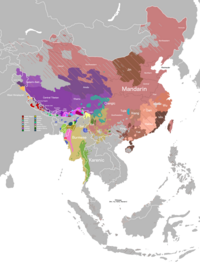Tangkhulic languages
| Tangkhulic | |
|---|---|
| Ethnicity | Tangkhul |
| Geographic distribution | Ukhrul District, Manipur, India; Naga Self-Administered Zone, Myanmar |
| Linguistic classification | Sino-Tibetan |
| Language codes | |
| Glottolog | sino1246 |
The Tangkhulic and Tangkhul languages are a group of Sino-Tibetan languages spoken mostly in northeastern Manipur, India. Conventionally classified as "Naga," they are not clearly related to other Naga languages, and (with Maringic) are conservatively classified as an independent Tangkhul–Maring branch of Tibeto-Burman, pending further research.
The Maringic languages appear to be closely related to the Tangkhulic family, but not part of it.
Languages
[edit]Tangkhulic languages include:
- Tangkhul (Indian Tangkhul)
- Somra (Burmese Tangkhul)
- Akyaung Ari
- Kachai
- Huishu
- Tusom
- Suansu
- Challow
- Kongai
The Tangkhulic languages are not particularly close to each other. Suansu, Challow, and Kongai were only documented starting from 2019.[1]
Brown's "Southern Tangkhul" (Southern Luhupa?) is a Kuki-Chin rather than Tangkhulic language. It has strong links with the recently discovered Sorbung language, which is also not Tangkhulic despite being spoken by ethnic Tangkhul.[2] some northern villages (Chingjaroi, Jessami, Soraphung Razai) in Tangkhul area have language more closely related to the Angami-Pochuri language group.
Koki, Long Phuri, Makuri, and Para are "Naga" languages spoken in and around Leshi Township, Myanmar. These four languages could possibly classify as Tangkhulic languages or Ao languages.[3]
Classification
[edit]Mortensen (2003:5) classifies the Tangkhulic languages as follows.
Reconstruction
[edit]Proto-Tangkhulic, the reconstructed ancestral proto-language of the Tangkhulic languages, has been reconstructed by Mortensen (2012).[4]
Mortensen (2003:5-7)[5] lists the following phonological innovations (sound changes) from Proto-Tibeto-Burman (PTB) to Proto-Tangkhulic.
- PTB *s- > *th-; PTB *ts-, *sy- > *s-
- PTB *dz-, *dzy-, *tsy- > *ts-
- PTB *ky-, *gy- > *ʃ-
- PTB *kr-, *tsy- > *c-
- Neutralization of vowel length distinctions in non-low vowels
- Dissimilation of aspiration in prefixes
Proto-Tangkhulic also has the nominalizing prefix *kV-.[5]
Proto-Tangkhulic lexical innovations are:[5]
- *war ‘mushroom’ (found exclusively in Tangkhulic)
- *kɔ.phuŋ ‘mountain’ (found exclusively in Tangkhulic)
- *kɔ.mi ‘to give’ (found exclusively in Tangkhulic)
- *khaj ‘fish’ (also found in some Zeme and Angami languages)
- *pan ‘hand’ (also found in some Zeme languages)
- *pej ‘foot’ (also found in some Zeme and Angami languages)
References
[edit]- ^ IVANI, Jessica K & ZAKHARKO, Taras. 2023. Linguistic diversity in North-East India: a comparative look at neighboring languages Suansu, Kongai and Challow. 26th Himalayan Languages Symposium, 4-6 September 2023. Paris: INALCO.
- ^ David Mortenson and Jennifer Keogh. 2011. Sorbung, an Undocumented Language of Manipur: its Phonology and Place in Tibeto-Burman. In JEALS 4, vol 1. http://jseals.org/JSEALS-4-1.pdf
- ^ Barkman, Tiffany. 2014. A descriptive grammar of Jejara (Para Naga). MA thesis, Chiang Mai: Payap University.
- ^ Mortensen, David R. 2012. Database of Tangkhulic Languages. (unpublished ms. contributed to STEDT).
- ^ a b c Mortensen, David R. (2003). “Comparative Tangkhul.” Unpublished Qualifying Paper, UC Berkeley.
- George van Driem (2001) Languages of the Himalayas: An Ethnolinguistic Handbook of the Greater Himalayan Region. Brill.
- Mortensen, David R. and James A. Miller (2013). “A reconstruction of Proto-Tangkhulic rhymes.” Linguistics of the Tibeto-Burman Area 36(1): 1-32.
- Mortensen, David R. (2012). Database of Tangkhulic Languages. (unpublished ms. contributed to STEDT).
- Mortensen, David R. and James A. Miller (2009). “Proto-Tangkhul Onsets in Comparative Perspective.” International Conference on Sino-Tibetan Languages and Linguistics 42, Chiangmai, November 4.
- Mortensen, David R. (2003). “Comparative Tangkhul.” Unpublished Qualifying Paper, UC Berkeley.
- Mortensen, David. 2014. The Tangkhulic Tongues - How I Started Working on Endangered Languages.

